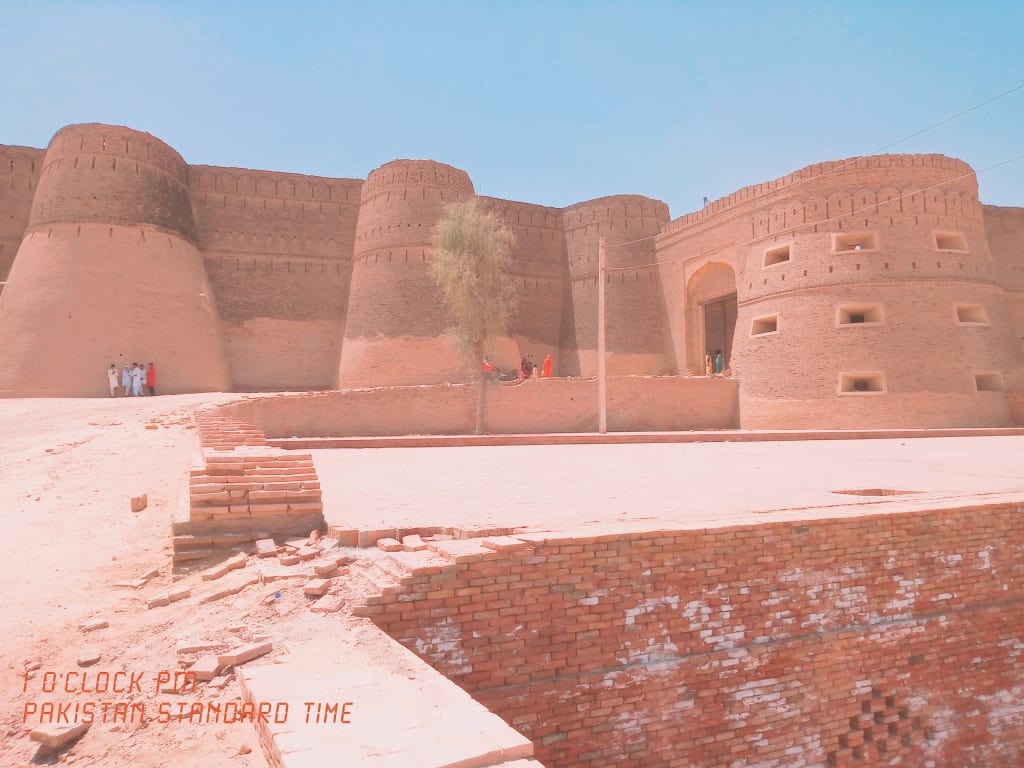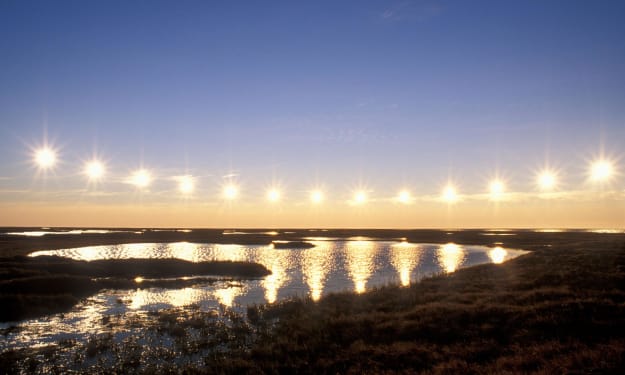
The Cholistan Desert comprises the western region of the Thar Desert in modern Pakistan, where archaeological evidence is present that the area was once inhabited by an Indus Valley culture. This culture once used the Hakra River to support their agricultural lifestyle. Although the river changed its flow, and the environment is now inhabitable, there remains evidence of up to a dozen fort structures. Derawar Fort is the best surviving structure of the remaining ruins.[3]
Derawar fort was built in the 9th century AD by Rai Jajja Bhati, a Hindu Rajput ruler of the Bhati clan,[4] as a tribute to emperor Rawal Deoraj Bhati[1][5] of Jaisalmer and residents of Bahawalpur. The fort was initially known as Dera Rawal, and later referred to as Dera Rawar, which with the passage of time came to be pronounced Derawar, its present name.[5]
In the 18th century, the fort was taken over by Muslim Nawabs of Bahawalpur from the Shahotra tribe. It was later renovated in its current form in 1732 by the Abbasi ruler Nawab Sadeq Muhammad, but in 1747 the fort slipped from their hands owing to Bahawal Khan's preoccupations at Shikarpur.[1] Nawab Mubarak Khan took the stronghold back in 1804. 1,000 year-old catapult shells were found in the debris near a decaying wall in the fort.[6]
Nawab Sadeq Muhammad Khan Abbasi V, the 12th and last ruler of Bahawalpur state, was born in the fort in 1904.[7]
Derawar Fort was eventually taken over by the British and was used to house prisoners, as well as hang unlucky inmates.[8]
Google Doodle made a doodle of Derawar Fort to celebrate Pakistan's 75 Independence Day.[2] According to Google, the fort symbolizes Pakistani adaptability and antiquity
Structure
The fort is a massive and visually stunning square structure built of clay bricks. The walls have a length of 1500 meters and stand up to thirty meters high. There are forty circular bastions, ten on each side, which stand 30 m high and are visible across the desert for many miles. Each bastion is intricately decorated with patterns cut into the brick. The interior provides evidence of structures decorated with tile and fresco artwork.[3]
Derawar is just one example of the wide variety of forms derived from square brick. These particular forms date back to between the 16th and 18th centuries, though some renovations date as early as the 9th century.
Renovation
The Fort was later renovated in its current form in 1732 by the Abbasi ruler Nawab Sadeq Muhammad. In 2019 the provincial government has earmarked a sum of Rs46 million to resume the conservation of Derawar Fort, an iconic edifice located in Cholistan desert near Bahawalpur. The major work has been completed including conservation of a food grain warehouse outside the fort, underpinning of damaged parts on the front and south-eastern sides of the fort’s bastion, walls and platform, underpinning of the north-eastern side of the bastion and the walls, the interior of the fort and the sloped flooring leading to baradari and walls adjacent to the main gate.
Despite renovation, the site faces extreme deterioration and neglect. Though the outside structure serves as an important example of history and landscape, the interior is falling apart due to severe weather conditions and disrespectful visitors and tourists. The woodwork is almost completely gone, along with the interior floor deteriorating to shambles.
Visiting Derawar
The trip to Derawar is a full day excursion requiring a three to four hour four-wheel drive led by local guides. In order to access the interior of Derawar, it requires permission from the Abbasi Family, as it is privately owned.
Each year a jeep rally is held in the Cholistan Desert that is attended by people from all over the world. Due to its popularity, it is estimated to be visited by more than 70,000 people. The rally passes through three districts in the desert
UNESCO tentative list
Derawar and the Desert Forts of Cholistan was submitted by the Pakistan Government in 2016 to be considered as a World Heritage Site. The structures are reminiscent of ancient stops during trading routes in a desert largely lacking water. Derawar especially allowed access to water, while providing defense and shelter. The site is important due to its role in identifying political and social factors relating to Afghanistan, Pakistan, and India trading routes.
Derawar is being considered under criterion (iii) which has to do with providing an important example of infrastructure designed to meet the environmental circumstances of the hostile desert while providing insight into ancient trade and culture, as well criterion (v) that claims Derawar is an exceptional example of the interaction of architecture with the limited environmental resources
About the Creator
Muhammad Ali Raza
I have enjoyed writing for most of my life, never professionally.
I wish to now share my stories with others, lets see where it goes.
Born and raised on the Pakistan Prairies, I currently reside on the Punjab.I call both places home.
Enjoyed the story? Support the Creator.
Subscribe for free to receive all their stories in your feed. You could also pledge your support or give them a one-off tip, letting them know you appreciate their work.
Reader insights
Outstanding
Excellent work. Looking forward to reading more!
Top insights
Compelling and original writing
Creative use of language & vocab
Eye opening
Niche topic & fresh perspectives
Heartfelt and relatable
The story invoked strong personal emotions






Comments (2)
Lol, did you just copy paste this whole thing from Wikipedia?
Great and informative article, very well written!😊